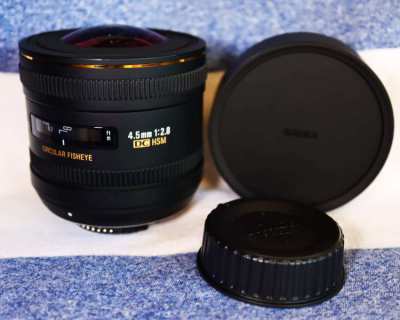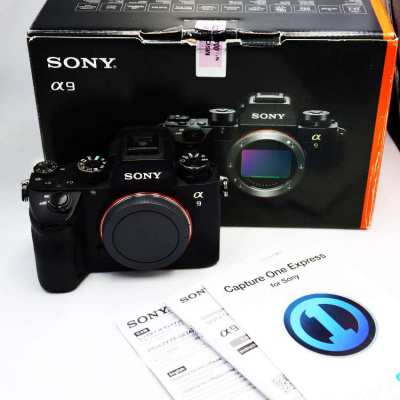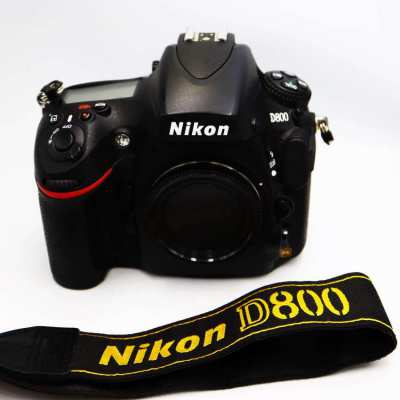Shutter counter: 8xxx
https://www.youtube.com/watch?v=HF2GOmsOr40
Review: https://www.kenrockwell.com/sony/a9.htm
Electronic shutter evolution: Sony A9, Olympus OM-D E-M1 II and Lumix G9: https://mirrorlesscomparison.com/in-depth/sony-a9-vs-olympus-omd-em1-ii/
Very good condition body with Body cap, battery, Wall charger, USB cable, Sony Eye cap, User Manual, Docs, Box.
Cosmetically, it has a lot of traces and scratches on body (look at photos) that don't affect quality of photos.
Mint condition of sensor and LCD screen.
Can be used normally with all functions.
The first Sony mirrorless with two card slots, complete silence and has the toughest mechanical shutter of any camera ever, "tested" to 500 000 cycles! The mechanical shutter is tough, and the silent electronic shutter has no moving parts to wear out — ever!
Not only do its images look great in every light and are always sharp and well exposed under very difficult and active conditions, the Sony A9 is a huge advance in sports, news, concert, motion-picture stills and corporate shooting because it does all this at 20 frames per second, tracking autofocus and setting exposure at 60 FPS in the background, and the best part is it does this in complete and total silence. It is an unworldly experience to be motoring along at 20 FPS with full tracking exposure and autofocus, get great exposure and color in each shot, and have this happen in complete silence.
It offers full autofocus over the entire frame, not just in the center of the picture like full-frame DSLRs. Autofocus is essentially instantaneous with the right lenses, and even with good consumer lenses it can track fast-moving targets in the dark at night.
It's also the first Sony mirrorless with two card slots, and has the toughest mechanical shutter of any camera ever, "tested" to 500,000 cycles! The mechanical shutter is tough, and the silent electronic shutter has no moving parts to wear out — ever!
Battery life is fantastic for sports shooting. While CIPA rated for only 480 shots for one-shot-at-a-time amateur shooting, in actual sports shooting where I make long bursts at 10 FPS, I can shoot 1,800 frames and only use 33% of the battery's capacity — or about 5,400 shots on a full charge! At 20 FPS I'd probably get even more.
The A9 is a landmark in photography; no pro camera has ever been able to go this fast, much less do it in complete silence.
My A9's tracking autofocus is the best I've ever used — better than the Nikon D5 or Canon 1DX Mk II — because it locks-on to the subject and tracks it longer and farther than any other AF system. It's crazy how my A9 finds the face all by itself, locks-on, tracks and won't let go like a pit bull all over the frame, even at the sides and corners. If there are multiple faces and the closest one turns away, my A9 actually pulls focus to the next nearest face immediately, always keeping the most relevant face in perfect focus. It's completely unlike any other pro camera; the closest thing before has been the RX10 Mk III which has a similar system and also works amazingly well. The A9 never misses a shot: it finds, tracks and keeps in focus whatever it is you're trying to shoot, and does it all automatically, presuming you're using a Sony GM lens that's up to the task.
A lot of this is because the A9's AF system is always looking at the subject, while at fast frame rates DSLRs spend very little time each second looking at the subject because the mirror is flipped up making exposures half the time or more.
The Sony A9 is all about Sony's newest-technology image sensor which, for the first time ever in full-frame, lets the A9 read the image from the entire sensor at about the same time. Because it's essentially read-out at once, gone are the "rolling shutter" effects of the past.
The A9 is in a completely different world than the older Canon 1DX Mk II and Nikon D5. The A9 runs significantly faster and with more resolution, but most importantly, does this in complete silence and the finder never blacks-out or gets smeary. You won't even know it's shooting other than the thin gray frameline that blips in the finder to let you know it's capturing frames.
You won't believe me until you get your own A9. The silent shutter mode isn't on by default; you have to set it at MENU > Camera 2 > page 4/9 > Shutter Type > ELEC. In silent mode you can be blazing away at twenty full 24 MP frames per second, even in raw with the A9's huge buffer, and no one may notice you're shooting. By comparison, every single frame in the "quiet" modes of the pro Canon 1DX Mk II and Nikon D5 are so loud that I can hear them echo off the neighbor's houses. The pro DSLRs are the very loudest cameras of all.
The A9 isn't about light weight, even though it's about as light as Sony's other full-frame cameras; the A9 is about outshooting Canon or Nikon, and doing it silently. The A9 is smaller and lighter than most, but not all, DSLRs, but when you add full-frame lenses to it, it loses most of the weight advantage. With a 50mm or 55mm f/1.8 lens, some full frame DSLRs like the Canon 6D actually weigh the same or less.
Many buttons are programmable, so you can program them to do just about anything.
It has three memory recalls on its top mode dial, so it's easy to set up one for photos of things (Vivid picture with +3 Saturation), one for people pictures (standard color with +1 Saturation), and the other for anything else, like sports or a custom white balance. If three memories aren't enough, there are four more hidden ones, M1, M2, M3 and M4, which are almost as easy to recall.
The AF and advance modes (frame rates) have their own knobs, so these don't save and recall.
New All-new sensor technology allows the camera to read the entire sensor almost at the same time, so the "rolling shutter" and blackout effects of earlier cameras are gone. We can shoot at 20 FPS and the finder never blinks. This is the first time anyone has done this in full-frame; the RX100 Mk V does this, but with a much smaller sensor.
693 phase-detection AF points cover the entire full-frame image. Your subjects can run, but they can't hide in the sides of the image.
Calculates exposure and autofocus at up to 60 frames per second.
Two card slots.
New thumb-nubbin controller on rear.
Three memory recalls on the top mode dial, with four more presets almost as easy to recall.
Drive mode dial.
Focus mode dial.
Two separate AEL and AF-ON buttons, instead of just one button with a selector lever as on A7RII, A7SII, A7II and A7.
C3 button moved to left side of camera; it's on the right on A7RII, A7SII, A7II and A7.
New, bigger NP-FZ100 battery lasts about 1,500 shots with burst shooting (rated 480 single shots).
In-camera 5-axis sensor-shift stabilization claims 5 stops improvement.
Turns on 30% faster than the A7R II; turns on and ready to shoot as quickly as I can bring it to my eye.
Shoots 4K video using the entire 36mm width of the image sensor.
Uncompressed 4K HDMI output (but the A9's LCD won't work in this mode).
XAVC S high-bitrate video formats for 50~100 MBPS video.
Under- and over-crank video from 1 FPS to 120 FPS, MOS (without sound).
Magnificent electronic finder: always big, bright, sharp and wonderful in any light. Super-bright in daylight, and dims perfectly indoors and at night.
Two card slots.
Hybrid AF system uses phase-detection for speed and contrast detection for ultimate precision and accuracy.
Battery life seems almost unlimited (up to 5,000 shots or more) running bursts at 20 FPS with the silent shutter.
Solid mostly metal construction.
Even the regular mechanical shutter only moves at the ends of exposures. There's never any need for a special vibration-free mode; it always works this way. Suck on that, LEICA!
Excellent high ISO performance.
Facial recognition works well, but only after you find it and turn it on.
In-finder 2-axis level works great for keeping horizons and vertical lines as they should be.
In-camera, as-shot automatic lens vignetting, lateral chromatic aberration and distortion correction.
Almost any lens of any brand or age can be adapted to work - but with no lens corrections.
Stereo microphone built-in.
3.5mm powered mic and headphone jacks.
Can extract stills from video, in-camera after it's shot. In other words, shoot 4K video and you can pull-out 8MP stills shot at 30 FPS.
Bluetooth & NFC...
The A9 uses the Sony E-Mount, formerly called the NEX mount, whose shallow 18mm flange focal distance allows better lens designs than DSLRs do — the same advantage rangefinder cameras have, as well as allowing just about any lens to mount with an adapter.
The A9 works best with all the lenses made by Sony, Zeiss and others for Sony's mirrorless E-Mount.
If you mount a Sony or Zeiss APS-C lens, it automatically uses only the central APS-C section of the full-frame sensor. You'd never know, since all the displays just look right. It's that seamless, but sort of silly to waste most of this camera's sensor area with an APS-C lens.
While you can adapt any lens of any brand or age to the A9, they won't work as well as native Sony or Zeiss FE lenses, or Alpha or MAXXUM lenses with the LA-EA4 adapter.
Those lenses autofocus extremely well, but once you use an off-brand lens or adapter, lenses that perform magnificently on their own brand of camera may or may not autofocus that well. If you demand the best performance, just use the same brand of lens as your camera. Adapters should never be your go-to for the best performance. Don't expect the best results for sharpness or for autofocus from other-brand adapters if you're picky.
Adapters are great for fun; you can get adapters cheap for any kind of lens, but not only may autofocus be iffy, adapted wide-angle lenses usually aren't very sharp on the sides at large apertures because Sony's full-frame mirrorless sensors are optimized for lenses with a curved fields. Most other adapted lenses won't seem very sharp on the sides at large apertures due their flat fields not interfacing well with the curved fields needed by Sony's sensors on these cameras. If you get the center in focus, the sides will probably be off, and if you get the sides in focus, the center will be off. This is more of a problem with wider lenses and at large apertures; stop a lens down and the sides will come into better focus.
The A9 runs at its full 20 FPS with adapted manual-focus lenses.
Metabones Mark V Adapter (you can buy in our shop)
The Metabones Canon EF to Sony E-Mount Mark V Adapter is the best I've used.
It works with every crazy Canon lens with which I tried it, and the results were usually much sharper than I expected.
Silent shooting: no one asks why I'm taking pictures, period. Sensor-stabilization makes it easy to hand hold at 1/15.
While LEICA lenses are the world's finest, they are not designed for the curved fields or rear nodal point positions optimized for the Sony cameras, and like all other adapted lenses, perform more poorly than Sony's own lenses because the sides and corners often aren't in proper focus.
LEICA lenses of 35mm and wider aren't as sharp as they should be at the sides. They sharpen up as stopped down, but if you want great results, use LEICA lenses on a LEICA camera, or use Sony's lenses on the A9. It all has to do with the specific alignment of micro lenses and layer configuration towards the sides of the sensor.
Specifically, there is a lot of field curvature induced by the design of the Sony sensor, and to focus at infinity at the sides with a modern semi-retrofocus LEICA SUPER-ELMARIT-M 21mm f/3.4 ASPH, you have to turn the focus ring to about 10'/3 meters! With the 1959 SUPER-ANGULON 21mm f/4 whose rear nodal point really is only about 21mm away from the image plane, you have to set the focus ring to about 3'/1 meter to get things at infinity in focus at the sides!!! Because of this, I've tried and confirmed that my cheap Voigtländer 21mm f/4 works about as well on my A9 as my genuine ASPH LEICA 21mm.
Not only does the combination of a LEICA (or other traditional Nikon or Canon) lens and Sony A9 sensor induce field curvature (there are a lot of optics and micro lenses on a sensor before you get to the light-sensitive part), it also induces astigmatism: the sagittal and meridional planes diverge.
There's no need to splurge for the latest APO ASPH LEICA lenses since the LEICA's (or anyone else's) lenses, with their flat fields are never going to be that sharp across a frame that's expecting a curved field lens. Therefore, it's best to select the lightest-weight (older) lenses rather than the hottest new ones. The performance of my LEICA SUMMICRON-M 35mm f/2 (7-element) is the same as with the newest LEICA SUMMICRON-M 35mm f/1.4 ASPH (floating element), so I prefer to use the older, lighter lens.
Here are two samples shot with the LEICA SUPER-ELMARIT-M 21mm f/3.4 ASPH at f/3.4 on the Sony A9. Click either to get the camera-original file and look at each at 100%:
Summary
Stick with lenses sold by Sony, be they branded Sony or Zeiss, for the best results as you expect. Sony's GM lenses are especially excellent in every way on the A9.
Adapting lenses of other brands, even though these lenses may be state-of-the-art on those manufacturers' cameras, probably won't be that breathtaking on the A9 — or any other camera of a brand different than the lens' manufacturer. Stick to Sony G and GM lenses on the A9 and you won't go wrong.
Auto ISO
Upper and lower limits selectable from ISO 100 to ISO 204,800 in full stops (limited to ISO 102,400 for video and ISO 25,600 with silent electronic shutter).
Slowest shutter speed settable in full stops from 1/16,000 to 30s in full stops, as well as an Auto setting that varies with the lens focal length. The Auto Slowest Shutter Speed setting my be varied ±2 stops slower or faster than the lens' focal length.
Image Sizes
Cropped Sizes
The A9 automatically crops the full-frame down to APS-C if you mount an APS-C lens, or you can set this manually (MENU > Camera 1 > page 1/13 > APS-C/Super 35mm > ON), and either of these 1.5:1 formats may also be set to a 16:9 crop.
On Left:
Ethernet (WLAN for FTP connections).
PC (Prontor-Compur) flash sync.
On Right:
3.5mm microphone jack with plug-in power.
3.5mm headphone jack.
Micro-D HDMI. The HDMI output supports 3,840 x 2,160 (25p), 1,920 x 1,080 (50p, 50i, 24p, 60p, 60i and 3,840 x 2,160 at 30p and 24p. YCbCr 4:2:2 8-bit and RGB 8-bit.
Multi/Micro USB 2.0.
On Top and Bottom:
Hot shoe, which is also a Sony "Multi Interface" Shoe.
Vertical Grip Connector (inside the battery chamber).
WiFi
IEEE 802.11 b/g/n
Infrastructure mode
2.4 GHz.
WEP, WPA-PSK and WPA2-PSK.
Wi-Fi Protected Setup (WPS) or Manual setup.
NFC
NFC Forum Type 3 Tag compliant
Bluetooth
v4.1.
2.4 GHz.
Model No. WW361847.
Power & Battery
Consumes about 4.1W (5.3W for video) using the finder and 3W (5.0W for movies) using the LCD.
Sony NP-FZ100 rechargeable lithium ion battery included
Magnesium alloy top cover, front cover, internal frame and rear cover.
The grip area has been reinforced with magnesium alloy.
Sony claims weather seals around most of the buttons and dials.
















